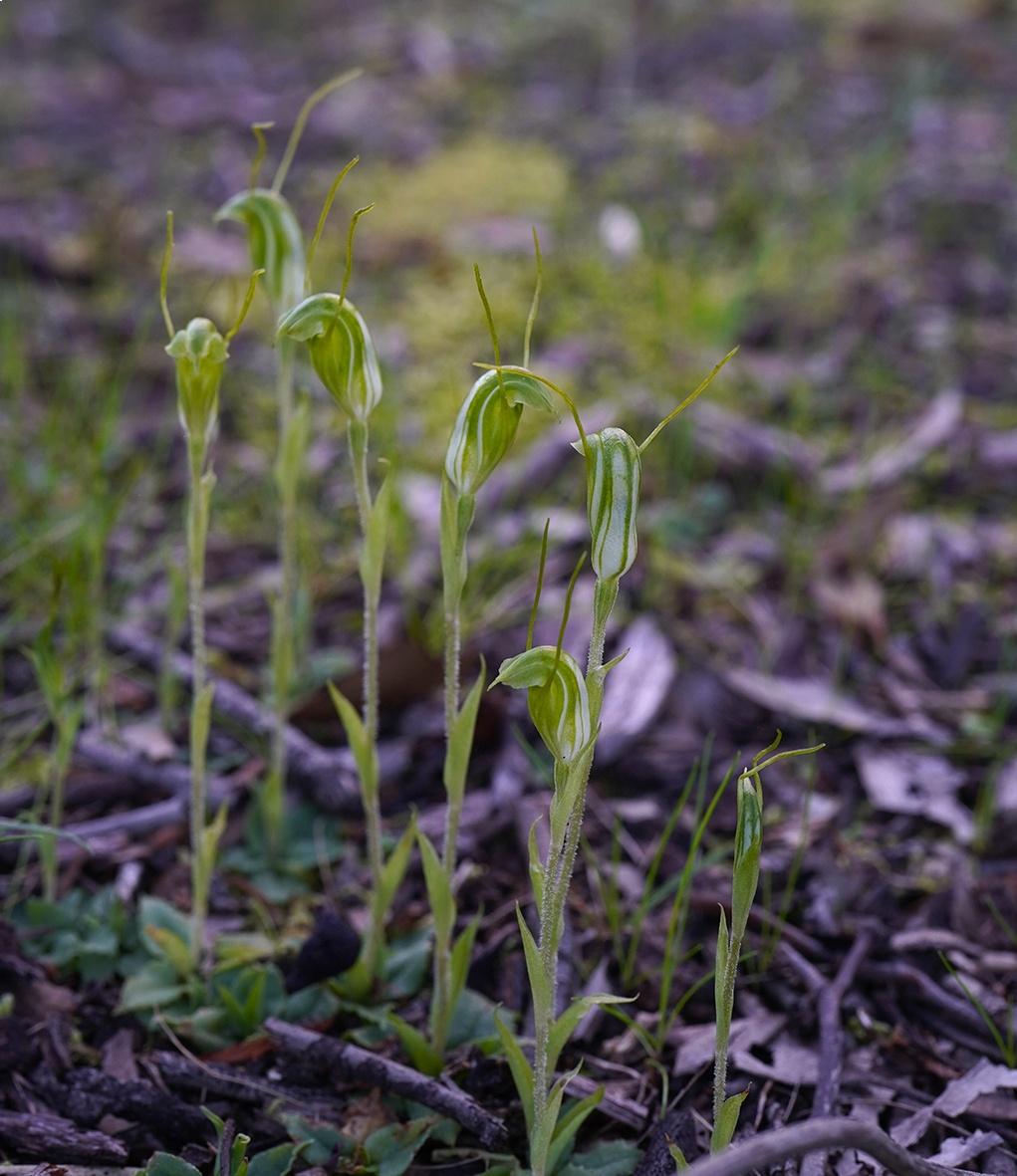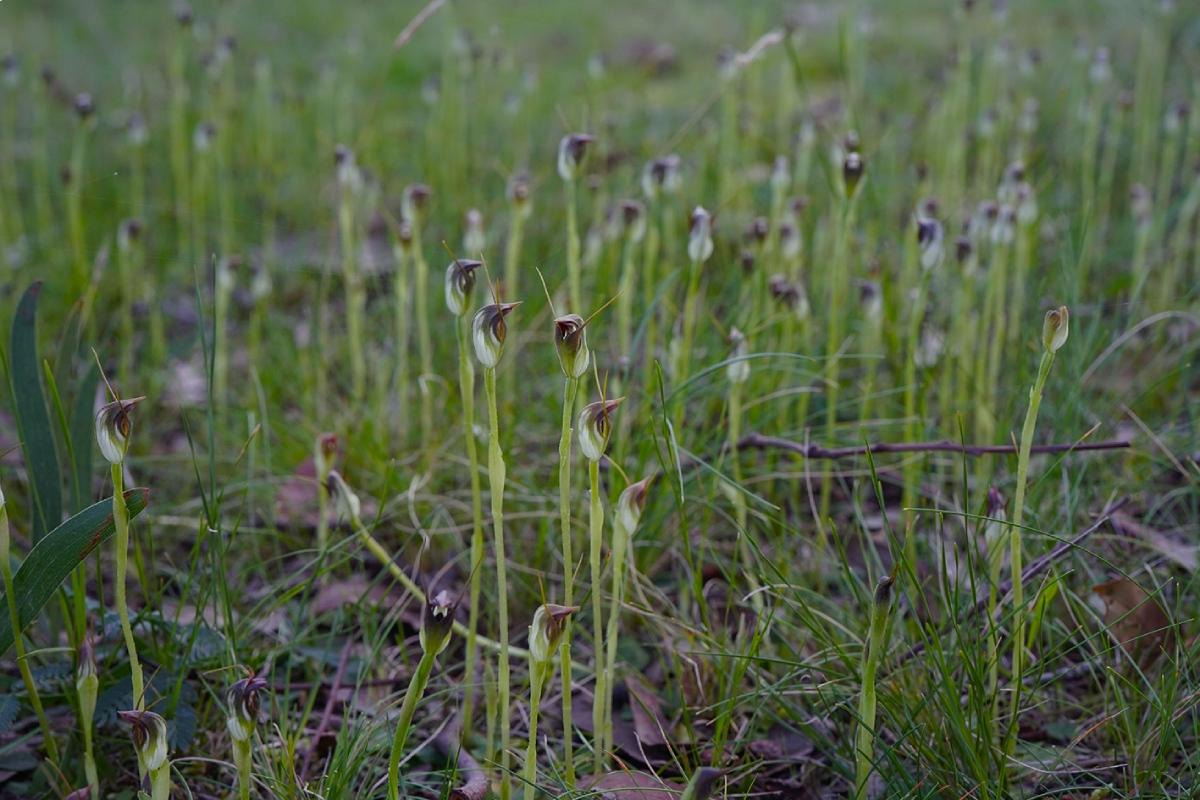Spring is the time of the year that we most look forward to, with many of our most impressive orchids flowering in this season. The first of our colourful orchids, the yellow and brown Leopard Orchid, Diuris pardina, was seen flowering in early August at Fairhaven, with further observations now recorded throughout the Anglesea district. Look for the brown blotches on the back of the long-stalked upright yellow petals.

Leopard Orchid
The second species of Diuris to flower in our district each year is the Donkey orchid, D. orientis, which usually flowers just as the Leopard orchids are finishing. The petals are large and erect, looking a little like donkeys’ ears. Later in spring you may find two more Diuris species, Golden Moths, D. chyseopsis, or the Tiger Orchid, D. sulphurea which are both rare in the district.

Donkey Orchid
Greenhood orchids are still continuing to impress us all with large colonies of the familiar Nodding Greenhood, P.nutans, being observed in many places. But there are now many other greenhood flowers to stumble upon. Small colonies of the tiny Dwarf Greenhoods, P. nana, are appearing in heathland and forests, and some magnificent colonies of Maroonhoods, P. pedunculata, have been observed.

Dwarf Greenhoods

Maroonhoods
The Blunt Greenhood, P. curta, with its large blunt flower and twisted labellum may be seen in open forests and woodlands. This species prefers Aireys Inlet to Anglesea, and is not often seen.

Blunt Greenhood
Tall Greenhoods, P. melagramma, are having a good year with many tall plants seen along the edge of tracks. Late in July we were excited to find a small number of the extremely rare Green-striped Greenhoods, P. chlorogramma, growing in the Gum Flat area. Similar in appearance to the Tall Greenhood, the shape of the hood is more rounded and usually has a green central stripe on the labellum, in contrast to the brown stripe on the labellum of the Tall Greenhood.
Look for the Anglesea endemic orchid, Unicorn Bearded Greenhood, P.unicornis, with the long pointed tip on the end of its hood. It is producing distinctive rosettes at the present time and should be flowering in September. The smaller, Southern Bearded Greenhood, P. tasmanica, starts flowering later in October. These are both rare orchids.
The first spider orchid we recorded to flower this year was on 11 August when the Wine-lipped Spider Orchid, Caladenia oenochila, was seen in flower in the O’Donohue area. This orchid can sometimes be confused with the Southern Spider Orchid, C. australis., which flowers later. This rare species also has a dark red labellum, but it has dark red flattened clubs on the sepals. Many other hairy spider orchids are appearing throughout the district but are not easy to identify until the flower appears.

Wine-lipped Spider Orchid
The distinctive Mayfly Orchid, Acianthus caudatus, with its long filamentous sepals and heart shaped leaves are being seen in many places and should continue to flower for many weeks. On warm days the flowers emit an unpleasant odour and this attracts a high level of insect activity. Both species of Gnat Orchids, Cyrtostylis reniformis and C. robusta are continuing to flower.

Mayfly
We were just waiting for Bluebeard Orchids, Pheladenia deformis, to appear, especially in the burnt areas where they often grow in spectacular clumps. Suddenly we got a message from Helen and Lance to say they had seen a small one at the top of Messmate Track.

Early Bluebeard
And the ever-reliable Wax-lip Orchid, Glossodia major, should very soon be seen in all shades of purple. We have observed many buds during the last few weeks so expect lots of flowers in the next few months.
Leaves of Hare Orchids, Leptoceras menziesii, are being seen in areas which have recently been burnt. Tiny buds are forming at the base of many of the leaves and this is very exciting, as although we have many colonies of leaves for this species each year throughout the district we seldom see flowers unless the area where they are growing has been burnt. We are hopeful for a spectacular display in spring. We are also seeing buds on the large fleshy leaves of Red Beaks, Pyrorchis nigricans, which will perhaps flower in September. This species also requires a burn to produce a flush of flowers although occasionally we find one or two flowers each year in an unburnt area.
Also flowering in September and known from just one site in the district, are Brown Beaks, Lyperanthus suaveolens. These orchids don’t need fire to flower.
You may ask what about the sun orchids. To many people these colourful orchids are the highlight of the orchid season. We can say that a variety of sun orchid leaves are appearing throughout the district and we were amazed to find two well-developed flower buds on the Great Sun Orchid, Thelymitra aristata in mid-August. If not taken by a hungry kangaroo or wallaby we should have some spectacular flowers to show in late September.

Great Sun Orchid in bud
We have also observed a good number of the wide leaves of the Blotched Sun Orchid, T. benthamiana. This is one of our later flowering sun orchids. The leaves appear early, but the flowers are usually seen in November and December. October is the peak month for the sun orchids so if there is a hot, sunny day early in October make sure you head out to enjoy their beauty.
These are just some of the orchids to be seen in the next few months, so please let us know if you find something special. We appreciate your support, and it is so important to record all sightings.
All of our orchids are documented and photographed in Orchids of the Anglesea District. The new edition costing $30.00 is available from the Angair Natural History Centre on Monday and Thursday mornings, online through the Angair website and from Anglesea News & Lotto and Great Escape Books in Aireys Inlet.
Margaret MacDonald margmacmoggs@icloud.com Alison Watson alisonw577@gmail.com